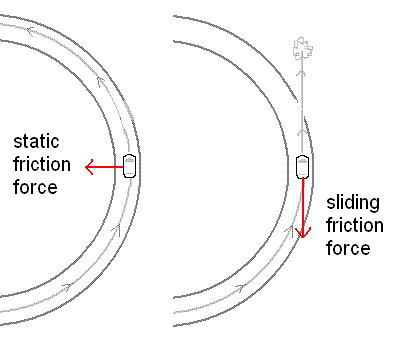
a skid might be larger than for
a car that is not skidding, but
the force is in the wrong direction
to do any good.
A rolling wheel seems to be moving, but it turns as it moves in such a way that the bottom part where where it touches the ground it is not moving relative to the ground itself. This means that static friction is involved, rather than sliding friction. This is important, since static friction does not transfer energy to the ground, while sliding does. There's a big difference between dragging a sled and pulling a wagon!

|
| The friction force on a car in
a skid might be larger than for a car that is not skidding, but the force is in the wrong direction to do any good. |
It is also important that there is static friction forces acting on the wheel, because the static friction force can be in any direction (to prevent motion in that direction), while the sliding friction force is always in the direction opposite to the motion. You will see the difference when you consider a car going around a curve: this requires a force that keeps the car from moving in a straight line, which pushes the car towards the inside of the curve. Static friction can do this, but sliding friction only produces a backwards force. A car in a skid cannot change the direction it is going; this is why cars are beginning to have special systems to prevent skids.
The friction force is larger when the force holding the two surfaces together is larger. Some people recommend putting something heavy in the trunk of a car or the back of a truck on icy days, to improve the friction. Unfortunately, this also increases the inertia of the car (a larger force will be needed to stop it), the kinetic energy of the car (it will do more damage if it doesn't stop), and the weight of the car (a larger force will be needed to make it go up a hill). The simple theory that physics professors teach indicates that the effects all cancel out, so that the stopping distance and the safe speed for going around curves does not change when the mass is increased (but the gasoline mileage will go down). Putting the right weight in the right place might be the right thing to do, but the analysis is not simple!